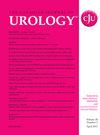Robotic-assisted laparoscopic pyelolithotomy in a horseshoe kidney.
IF 0.9
4区 医学
Q3 UROLOGY & NEPHROLOGY
Canadian Journal of Urology
Pub Date : 2024-12-01
引用次数: 0
Abstract
Nephrolithiasis is one of the most common indications for surgery in patients with a horseshoe kidney. Robotic-assisted surgery has become a staple in urologic practice, yet its application in stone management is largely undefined. We present a patient with a horseshoe kidney, who underwent a robotic-assisted laparoscopic pyelolithotomy (RPL) to treat a 3 cm stone burden. This procedure allowed for safe access that could not be obtained with percutaneous nephrolithotomy (PCNL) and stone removal without fragmentation, which would have been challenging with traditional laparoscopy. We advocate for the use of robotic-assisted laparoscopic pyelolithotomy in cases of aberrant anatomy complicating a heavy stone burden.
机器人辅助的马蹄肾腹腔镜肾盂取石术。
肾结石是马蹄形肾患者最常见的手术指征之一。机器人辅助手术已成为泌尿外科实践的主要内容,但其在结石管理中的应用在很大程度上尚不明确。我们报告了一位马蹄肾患者,他接受了机器人辅助的腹腔镜肾盂取石术(RPL)来治疗3厘米的结石负担。该手术允许安全进入,这是经皮肾镜取石术(PCNL)和无碎裂取石术所无法获得的,这对于传统腹腔镜来说是一个挑战。我们提倡使用机器人辅助腹腔镜肾盂取石术在异常解剖复杂的沉重的结石负担的情况下。
本文章由计算机程序翻译,如有差异,请以英文原文为准。
求助全文
约1分钟内获得全文
求助全文
来源期刊

Canadian Journal of Urology
UROLOGY & NEPHROLOGY-
CiteScore
1.90
自引率
0.00%
发文量
86
审稿时长
6-12 weeks
期刊介绍:
The CJU publishes articles of interest to the field of urology and related specialties who treat urologic diseases.
 求助内容:
求助内容: 应助结果提醒方式:
应助结果提醒方式:


